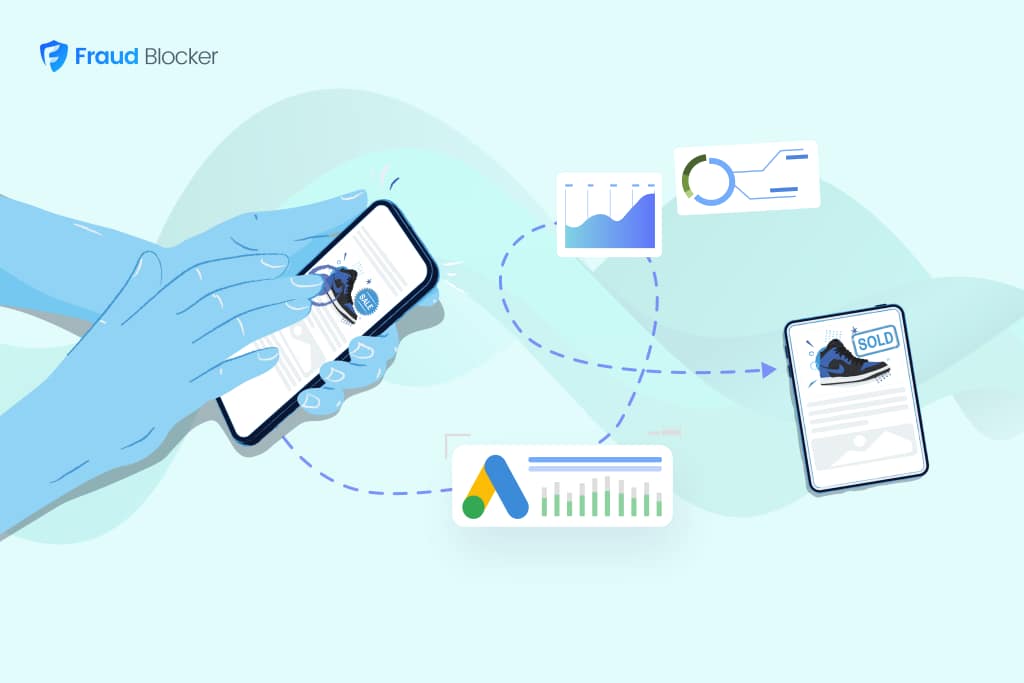
NEW New feature: Verify & block fake emails

We improve your ad performance by blocking click fraud and fake emails

Click fraud is costing advertisers billions in loses. Learn more here.

Click fraud is costing advertisers billions in loses. Learn more here.
As a marketer, you can optimize everything from copy and creatives to audience targeting, only to watch click-through rates drop by 50% seemingly overnight. The culprit?
Ad fatigue.
Users see hundreds of ads every single day. At first, your ad might grab attention, but the moment it starts to feel stale, they stop engaging. They instinctively skip videos on YouTube, scroll past on Google, and your costs begin to rise as conversions disappear.
The worst part is that most marketers don’t even realize it’s happening. Instead, they keep increasing budgets, tweaking targeting, and testing variations, trying to optimize a campaign users are actively avoiding.
At Fraud Blocker, we’ve seen this firsthand. Running multiple campaigns, we’ve experienced how quickly ad fatigue sets in and how to stop it before it wrecks performance. In this guide, we’ll be sharing our best strategies for beating ad fatigue. But first…
Ad fatigue is when an audience sees the same ad too many times and stops engaging with it. The first few impressions might interest them, but after repeated exposure, that interest fades. Up to 70% of users even become annoyed when they repeatedly see the same ad, according to Picnic.io.
But ad fatigue isn’t just an annoyance; it can harm your campaign’s profitability because it brings a drop in performance, rise in CPC, and makes conversions vanish. If you don’t catch it early, you could be paying more for ads that are being ignored.
If your campaign’s audience has ad fatigue, the odds are very high that you’ll see a few of these signs:
Spiralytics has an amazing Facebook Ads case study where they show ad fatigue creeping up in real time. As frequency (imp/person) hits 4, important metrics begin to tank; Costs Per Click, Cost Per Lead, and Ad spend all rise. And it’s only downhill from there.
Learn how to calculate PPC formulas and stay on top of your ad performance.
Ad fatigue doesn’t hit every platform the same way. On TikTok, users scroll past without a second thought, but on LinkedIn, the niche audience sees the same ad on repeat. Ignore these differences, and your campaign performance tanks faster than you expect.
Here’s how ad fatigue plays out across the major platforms and why you need different strategies for each.
Google Search Ads thrive on search intent, so fatigue builds slowly but expensively. Since users seek solutions, stale ads aren’t immediately ignored. But when fatigue sets in, your costs spike.
Signs of fatigue on Google Search Ads:
Unlike search ads, display ads are shown while users browse websites or apps. Since they aren’t actively looking for the ad’s offer, fatigue can happen faster. Display ads also rely on frequency-based impressions, which means users may see your ad multiple times across different sites.
Signs of fatigue on Google Display Ads:
Meta Ads rely heavily on visuals, and users are there for the engaging content. If ads don’t immediately grab their attention, people scroll away, and ad fatigue can set in quickly if users see the same creative multiple times in their feed.
Signs of fatigue on Meta ads:
You can see how many people have hidden your ads on Meta by going to Business Manager > Page posts > All posts > Click on post.
Up to 90% of people already skip YouTube pre-roll ads out of habit. So, your ads are already facing stiff competition here.
TikTok ads can be just as challenging, as the platform recommends in-feed ads be 9-15 seconds long. Ad fatigue can happen when users see the same un-engaging videos over and over again. TikTok’s algorithm is even known to suppress ads that users skip too frequently, speeding up ad decay.
Some of the signs of ad fatigue on TikTok and YouTube include:
Learn more about how YouTube view bots and TikTok spam bots affect users’ experience on the platform.
Ad fatigue tends to kick in faster on LinkedIn and Microsoft Ads because the audiences are more niche. Users tend to log in less frequently (48.5% of users are active monthly vs 96% on X), which means they are more likely to see the same thing repeatedly.
When this happens, you can expect to see signs like:
We’ve managed ad campaigns across multiple channels, and one thing is clear: ad fatigue has real consequences and can undermine all your campaign optimization efforts.
Below are five of the most effective strategies to fight ad fatigue that we’ve seen over the years. Remember, you know your business and customer best, so make sure to tailor these as needed.
Refreshing your ad creative frequently is the most powerful way to prevent fatigue. When you introduce new images, videos, or ad copy, you “reset” your audience’s interest. Top advertisers make this a habit: one analysis found that top-performing Meta advertisers created 51% more new content per month than average performers.
Remember: ad fatigue is about how quickly users get tired of seeing your ad, not necessarily the strength your message. Here are some tips when updating your creative:
Plan a refresh cadence. This can be as simple as updating your creative every 2 weeks in active campaigns.
Leverage Dynamic Creative Optimization (DCO). Many platforms like Google and Meta have some form of DCO – automatically testing and adjusting different ad elements in real time, so your audience always sees a fresh, relevant version.
One very useful tool is Meta’s Advantage+ Creative, which can change ad elements dynamically so even if users see the ad several times, it looks slightly different.
You can also use other dynamic creative options like:
🚨Warning: DCO solutions (like Meta’s Advantage+ Creative) may use AI image generation, which 50% of users find as a turn off, according to a YouGov survey. When our team uses AI tools, we monitor the output closely, and you should do the same.
One of the easiest ways to fight ad fatigue is limiting how often the same user sees an ad. With frequency capping, you control the number of impressions per person; they see the ad less often, which means there’s a longer window before getting overwhelmed.
Here’s an example of a frequency capping strategy:
You can even take this one step further by capping clicks, not just impressions on your ads. Fraud Blocker lets you limit the number of times users can click on your ads, which protects you from paying more for click throughs from fatigued users, but also prevents click fraud
in your ads.
Simply navigate to customizations in your dashboard > detection rules > Excessive clicking.
Pro tip for writing good copy for Google ads: most ads have a shelf life, no matter how well they perform. Instead of waiting for performance to drop, proactively refresh ad creatives before fatigue sets in. Some ways to do this:
For Facebook, Instagram and Google, consider rotating creatives every 2-4 weeks, and more frequently for fast paced platforms like TikTok.
We also like to keep an eye on metrics like CTR and CPC in real time. While benchmarks vary, we highly recommend trying something new if you notice engagement drop by more than 15%.
Read More: Powerful exclusions to stop wasted spend in Google Ads.
Personalization makes a massive difference in ad fatigue because the more relevant the ad feels, the less likely users are to tune it out. Generic ads, on the other hand, get ignored, skipped, or even blocked.
Ad customizers are an easy win here, because they can help vary headlines and CTA text based on location (e.g., “Get Fraud Protection in [City] Today”), or offer products that match your real-time inventory levels.
It also comes down to basic psychology. You’re more likely to click an ad if it feels like it was created for you.
Ad fatigue isn’t the only threat to your marketing budget; click fraud and invalid traffic waste up to $84 billion in ad spend every year, draining resources without delivering real results. You can optimize everything in your campaigns from copy to creative, and it won’t mean a thing if bots and competitors are constantly clicking your ads
Fraud Blocker identifies and blocks invalid clicks, preventing fraudulent traffic from skewing your campaign performance and wasting your budget. By eliminating click fraud, our solution helps businesses maximize ROI and keep ads in front of real, interested users.
Start a free trial today and see how Fraud Blocker can boost your ad performance.

ABOUT THE AUTHOR
Matthew Iyiola
Matthew is the resident content marketing expert at Fraud Blocker with several years of experience writing about ad fraud. When he’s not producing killer content, you can find him working out or walking his dogs.
Matthew is the resident content marketing expert at Fraud Blocker with several years of experience writing about ad fraud. When he’s not producing killer content, you can find him working out or walking his dogs.


